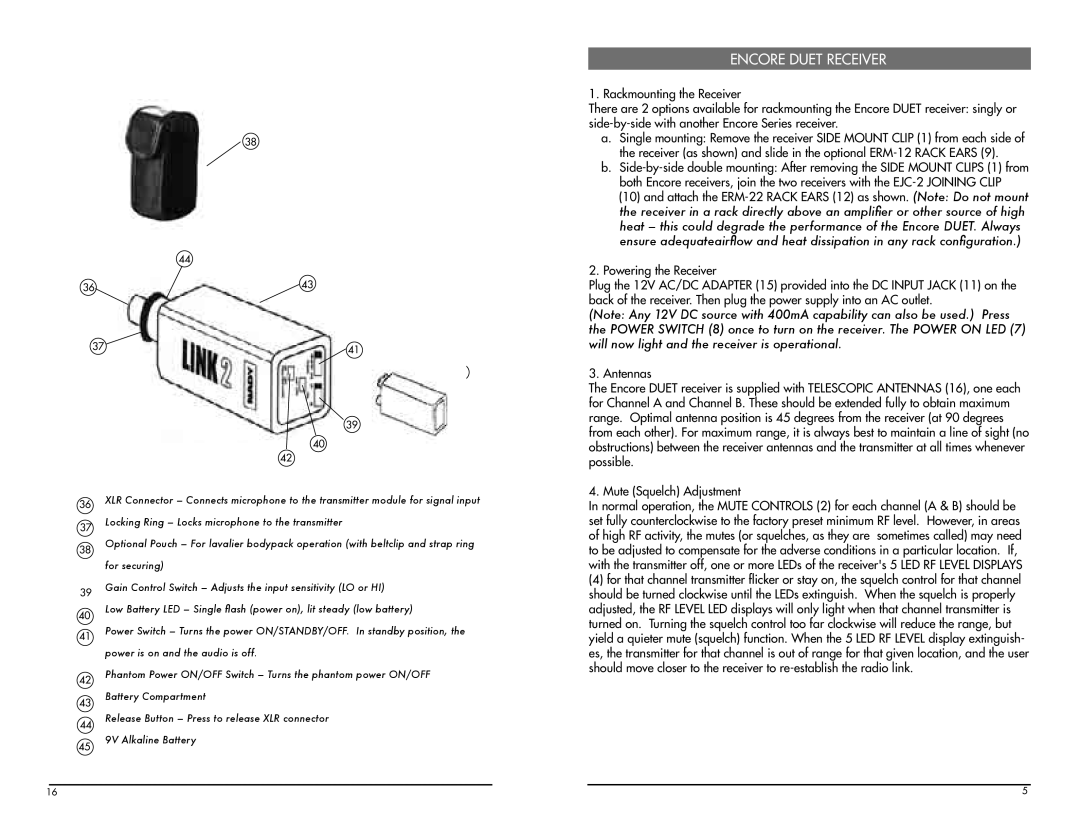
38
| 44 |
36 | 43 |
37 | 41 |
|
![]() 45
45
39
40
42
36XLR Connector – Connects microphone to the transmitter module for signal input
37Locking Ring – Locks microphone to the transmitter
38Optional Pouch – For lavalier bodypack operation (with beltclip and strap ring for securing)
39Gain Control Switch – Adjusts the input sensitivity (LO or HI)
40Low Battery LED – Single flash (power on), lit steady (low battery)
41Power Switch – Turns the power ON/STANDBY/OFF. In standby position, the power is on and the audio is off.
42Phantom Power ON/OFF Switch – Turns the phantom power ON/OFF
43Battery Compartment
44Release Button – Press to release XLR connector
459V Alkaline Battery
ENCORE DUET RECEIVER
1. Rackmounting the Receiver
There are 2 options available for rackmounting the Encore DUET receiver: singly or
a.Single mounting: Remove the receiver SIDE MOUNT CLIP (1) from each side of the receiver (as shown) and slide in the optional
b.
(10) and attach the
2.Powering the Receiver
Plug the 12V AC/DC ADAPTER (15) provided into the DC INPUT JACK (11) on the back of the receiver. Then plug the power supply into an AC outlet.
(Note: Any 12V DC source with 400mA capability can also be used.) Press the POWER SWITCH (8) once to turn on the receiver. The POWER ON LED (7) will now light and the receiver is operational.
3. Antennas
The Encore DUET receiver is supplied with TELESCOPIC ANTENNAS (16), one each for Channel A and Channel B. These should be extended fully to obtain maximum range. Optimal antenna position is 45 degrees from the receiver (at 90 degrees from each other). For maximum range, it is always best to maintain a line of sight (no obstructions) between the receiver antennas and the transmitter at all times whenever possible.
4. Mute (Squelch) Adjustment
In normal operation, the MUTE CONTROLS (2) for each channel (A & B) should be set fully counterclockwise to the factory preset minimum RF level. However, in areas of high RF activity, the mutes (or squelches, as they are sometimes called) may need to be adjusted to compensate for the adverse conditions in a particular location. If, with the transmitter off, one or more LEDs of the receiver's 5 LED RF LEVEL DISPLAYS
(4)for that channel transmitter flicker or stay on, the squelch control for that channel should be turned clockwise until the LEDs extinguish. When the squelch is properly adjusted, the RF LEVEL LED displays will only light when that channel transmitter is turned on. Turning the squelch control too far clockwise will reduce the range, but yield a quieter mute (squelch) function. When the 5 LED RF LEVEL display extinguish- es, the transmitter for that channel is out of range for that given location, and the user should move closer to the receiver to
|
|
|
|
16 |
| 5 | |
